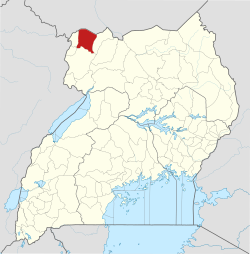Yumbe District
Yumbe District | |
|---|---|
 District location in Uganda | |
| Coordinates: 03°28′N 31°15′E / 3.467°N 31.250°E | |
| Country | |
| Region | Northern Uganda |
| Sub-region | West Nile sub-region |
| Capital | Yumbe |
| Area | |
| • Total | 2,393 km2 (924 sq mi) |
| Population (2012 Estimate) | |
| • Total | 545,500 |
| • Density | 228/km2 (590/sq mi) |
| Time zone | UTC+3 (EAT) |
| Website | web |
Yumbe District is a district in Northern Region, Uganda. Like most other Ugandan districts, it is named after its 'chief town', Yumbe, where the district headquarters are located.
Location[edit]
Yumbe District is one of Uganda's most northern districts. The district is bordered by South Sudan to the north, Moyo District to the east, Adjumani District to the southeast, Arua District to the south, Maracha District to the southwest and Koboko District to the west.[1] The district headquarters at Yumbe are located approximately 75 kilometres (47 mi), by road, north of Arua, the largest town in the sub-region.[2] The coordinates of the district are:03 28N, 31 15E.
Overview[edit]
Yumbe District was established in 2006 when Aringa County was split off Arua District and renamed Yumbe District.The people in the district are still suffering from the effects of the civil war, which lasted about twenty years (1980–2000). The peace agreement between UNRF2 and the Government of Uganda was signed in the year 2000 in Yumbe.
The majority (89%) ethnicity in the district are the Aringa people. Other ethnicities include the Kakwa, Madi and the Alur. The Acholi are scattered along River Nile and mainly engage in fishing and hunting, along the river. They account for about 2% of the district's population.
The languages spoken in the district include: the Aringa language (majority), Kakwa language, Madi language and the Alur language. The second most-spoken language however is Kiswahili. In the urban areas, one might encounter individuals who can understand Arabic or English.
Population[edit]
Yumbe is the only district in the country with a mainly Muslim majority population (76%),[3] which is a big exception for Uganda, where 85% of the population is Christians.[4] The fertility rate in the district is high (7.5).[5]
In 1991, the national population census estimated the district population at about 99,800. The 2002 national census estimated the population of the district at about 251,800 inhabitants. The annual population growth rate in Yumbe District was calculated at 8.2%. It was estimated that the population of Yumbe District in 2012 was approximately 545,500.[6]
Economic activities[edit]
SCHOOLS IN YUMBE DISTRICT[edit]
- Kado Secondary School zone four.
- Excel international secondary school zone two.
- Nipata secondary school zone three.
- Ebenezer secondary school zone one.
- Kingsland secondary school.
- yoyo secondary school zoner three.
- Valley view secondary school zone one.
- Yumbe secondary school.
- Apo seed secondary school.
- midigo primary school.
- Barakala secondary school.
- Lodonga secondary school.
- Kuru secondary school.
- Aringa secondary school.
- King′s modern secondary school.
- Odravu secondary school.
- Govule Primary School.
- primary school Education zone one.
- Yangani Primary School zone four.
- Barakara Primary School zone one.
- Knowledge Land primary school zone four.
- Kado Primary School zone four
- Rockland Primary School zone one.
- Life foundation zone four.
- Kejebere primary school zone two.
- Molondo primary school zone two.
- Alaba primary school zone two.
- Kena valley primary school zone two.
- Kodeje primary school zone two.
- yoyo central primary school zone three.
- Nipata valley primary school zone two.
- High land primary school zone three.
- Abriamajo primarythree.hool zone four.
- Hill top primary school zone three.
- Dradranga primary school zone three.
- Luzira primary school zone three.
- peace primary school zone three.
- Ambiya primary school zone three.
- yoyo primary school zone three.
- mengo primary school zone
- Luzira Bright view primary school zone three.
- scKoro primary school zone three.
- Twajiji hope primary school zone one.
- Ofonzi primary school zone one.
- Alpha primary and nursery school zone one.
- Arizu primary school zone one
- Happy Joy early Childhood development (ECD) zone three.
- New Generation early childhood development zone three.
- Bright ECD Centre zone one.
- Daddy's care ECD Centre zone one.
- Rock land ECD Centre zone one.
- Green valley ECD Centre zine one.
- Happy Joy ECD Centre four.
- Happy child friendly space zone four.
- Kala early childhood development(ECD) zone three.
Subsistence agriculture is the main economic activity in the district, as is the case with most Ugandan districts. Crops grown include the following:[7]
See also[edit]
References[edit]
- ^ Uganda District Map
- ^ "Map Showing Arua And Yumbe With Distance Marker". Globefeed.com. Retrieved 22 May 2014.
- ^ "Self-Reported Religious Affiliations of Ugandans In 2002, By District" (PDF). Uganda Bureau of Statistics. 2002. Retrieved 22 May 2014.
- ^ Census 2014 Final Results
- ^ "Population Dynamics of Ugandans In 2002, By District" (PDF). Uganda Bureau of Statistics. Retrieved 22 May 2014.
- ^ "Estimated Population of Yumbe District In 1991, 2002 & 2012". Citypopulation.de. Retrieved 22 May 2014.
- ^ "Profile of Yumbe District". Uganda Travel Guide. Retrieved 22 May 2014.
